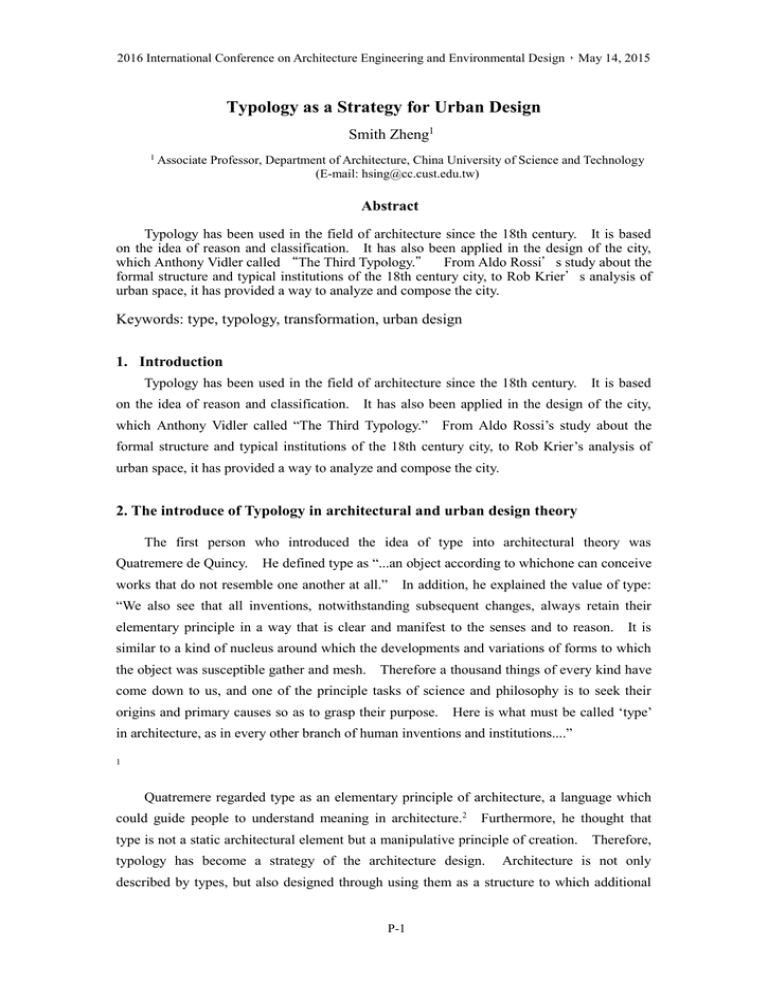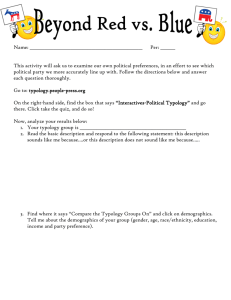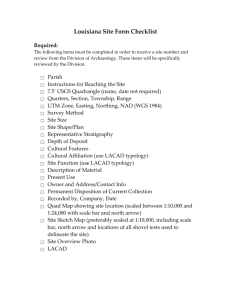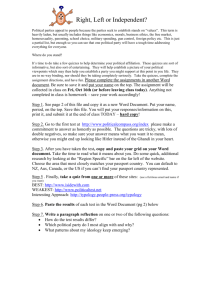201* International Conference on Architecture Engineering and
advertisement

201 International Conference on Architecture Engineering and Environmental Design,May 14, 2015 Typology as a Strategy for Urban Design Smith Zheng1 1 Associate Professor, Department of Architecture, China University of Science and Technology (E-mail: hsing@cc.cust.edu.tw) Abstract Typology has been used in the field of architecture since the 18th century. It is based on the idea of reason and classification. It has also been applied in the design of the city, which Anthony Vidler called “The Third Typology.” From Aldo Rossi’s study about the formal structure and typical institutions of the 18th century city, to Rob Krier’s analysis of urban space, it has provided a way to analyze and compose the city. Keywords: type, typology, transformation, urban design 1. Introduction Typology has been used in the field of architecture since the 18th century. It is based on the idea of reason and classification. It has also been applied in the design of the city, which Anthony Vidler called “The Third Typology.” From Aldo Rossi’s study about the formal structure and typical institutions of the 18th century city, to Rob Krier’s analysis of urban space, it has provided a way to analyze and compose the city. 2. The introduce of Typology in architectural and urban design theory The first person who introduced the idea of type into architectural theory was Quatremere de Quincy. He defined type as “...an object according to whichone can conceive works that do not resemble one another at all.” In addition, he explained the value of type: “We also see that all inventions, notwithstanding subsequent changes, always retain their elementary principle in a way that is clear and manifest to the senses and to reason. It is similar to a kind of nucleus around which the developments and variations of forms to which the object was susceptible gather and mesh. Therefore a thousand things of every kind have come down to us, and one of the principle tasks of science and philosophy is to seek their origins and primary causes so as to grasp their purpose. Here is what must be called ‘type’ in architecture, as in every other branch of human inventions and institutions....” 1 Quatremere regarded type as an elementary principle of architecture, a language which could guide people to understand meaning in architecture.2 Furthermore, he thought that type is not a static architectural element but a manipulative principle of creation. Therefore, typology has become a strategy of the architecture design. Architecture is not only described by types, but also designed through using them as a structure to which additional P-1 201 International Conference on Architecture Engineering and Environmental Design,May 14, 2015 elements can be added. Deriving from Quatremere’s concept of typology, the “Third Typology” has proposed using the typology as a strategy to analyze and design the cities. The “Third Typology” regards the city as a formal structure that can be understood through its historical development. It emphasizes the continuity of form and history. The city is considered by Vidler as a whole, that all of its elements --buildings, streets, urban spaces, are associated in an indestructible chain of continuity and meaning. Moreover, its physical structure discloses its past and present.3 Therefore, analyzing the types of the cities can enable us to understand the ideas and values of the cities and provide the structure for urban design. In addition, architects can improve the clarity of city structures and the meaning, associated through urban life by the use of typology. Architects who work with types can resolve the problem inferred in the context. As Vidler pointed out, typology is a strategy to make architects “direct their design skills to solving the questions of avenue, arcade, street and square, park and house, institution and equipment in a continuous typology of elements that together coheres with past fabric and present intervention to make one comprehensive experience of the city.”4 3. What is Typology? (Ideas of Typology and Typology as a Strategy for Urban Design) Typology is a rational method to analyze and classify distinct visual organizations that are called types. As Hayden White said : “...the beginning of all understanding is classification...”5 Therefore, types are based on understandable distinctions. When we understand one type, it is because we have found an order to it. For example, we regard the basilica (see figure 1) as one type, because we know how it has been organized and the differences between this organization and all others. Aldo Rossi thinks that the concept of type is a logical structuring principle of architecture. He regards the architectural artifact as a structure. In addition, this structure is exposed and can be recognized in the artifact itself. Therefore, “...typology presents itself as the study of types of elements that cannot be further reduced, elements of a city as well as of an architecture.”6 3.1 Definition of Type Basically, type can be said as “ a group of objects characterized by the same formal structure.” Furthermore, type might even represent “the act of thinking in groups.” 7 For example, one may talk about housing in general; however, “the act of thinking in groups” will push toward talking about housing as single houses, as courtyard houses, as rowhouses, as apartments. The idea of group understanding provides a way to understand the classification of architectural and urban elements using structural similarities. However, type is not an abstract formal structure; it implies meaning. It must connect P-2 201 International Conference on Architecture Engineering and Environmental Design,May 14, 2015 with the reality -- the history. As Rafael Moneo said: “...type as a formal structure is also intimately connected with reality -- with a vast hierarchy of concerns running from social activity to building construction. Ultimately, the group defining a type must be rooted in this reality as well as an abstract geometry.”8 This means type has a precise position in history, and therefore it is understandable. Type represents the ideas and values of history. In other words, type influences the meaning of the architecture form through the interaction of organization and architectural elements. Figure 1 Plan of Basilica (Basilica of Trajan, Rome, 98-112: (a) entrance, (b) altars surrounded by tribunals in apses, (c) libraries, (d) Trajan’s Column.) Figure 2 Plan of Greek Cross Church (St. Mark’s, Venice) Source: redrawing from Jordan, 1991: p.77. Source: redrawing from Jordan, 1991: p.95. For instance, the plan of Savannah (see figure 3) is a type of city. Its equal distribution of squares implies the social equality--which derived from the social ideas and values of the founder of the city. The analysis of typology can provide us a way to understand different ideas and values of a society. 3.2 Selection of Types The selection of type is dependent on the ideas and meaning that it implies. Type is the irreducible combination of elements -- its form and content, that represents ideas. For example, the central-planned church of Greek Cross (see figure 2) is a type of church. The combination of its elements represents the religious ideas that can be read through the understanding of tradition and history. Meaning is dependent upon the choice of type and the ideas that it infers within a particular culture. For instance, when an architect chooses the Greek Cross plan as a type for designing a church rather than other types, it is because this specific type has meaning that can be understood within that specific culture. P-3 201 International Conference on Architecture Engineering and Environmental Design,May 14, 2015 When an architect chooses a type as the base of a design, there are always ideas behind the choice of type. For instance, William Penn laid out the plan of Philadelphia (see figure 7) by referring to Cataneo’s Ideal City plan (see figure 6). This plan represented the idea that he hoped to build his own Ideal City for a democracy. He then transformed his choice of type to fit his ideas and values, to make the form more precise. 3.3 Transformation of Types The concept of the type, the irreducible combination of elements, implies the idea of transformation. According to Rafael Moneo, Quatremere de Quincy thought that: “the concept of type enabled architecture to reconstruct its link with the past, forming a kind of metaphorical connection with the moment when man, ..., confronted the problem of architecture and identified it in a form.”9 been transformed. Through the shift of context and history, type has When an architect selects the types from history, these selected types can be transformed to fit the particular context and culture which he is working in. In addition, the ideas of the selected types will be retained in the fundamental design. As Anthony Vidler points out, “when a series of typical forms are selected from the past of the city, they do not come, however dismembered, deprived of their original political and social meaning. The original sense of the form, the layers of accrued implication deposited by time and human experience cannot be lightly brushed away ... Rather, the carried meanings of these types may be used to provide a key to their newly invested meaning.”10 Therefore, “type is not only a static architectural element; it is also an operative principle of creation.”11 Speaking of the transformation of type, Rafael Moneo has described some strategies about the transformation. He said: “In this continuous process of transformation, the architect can extrapolate from the type, change its use; he can distort the type by means of transformation of scale; he can overlap different types to produce new ones. He can use formal quotation of a known type in a different context, as well as create new types by a radical change in the techniques already employed.”12 This provides some sense about the manipulation of the types. 3.4 Typology as a Strategy for Urban Design The use of typology is an important strategy for urban design. By using types to organize the city, an architect can rationally control urban forms and make improvements for urban life. Because of that “a sense of urbanism or a process of city planning was one of the procedures by which the Enlightenment aestheticized absolute power -- parceling and redistributing it through a utopia of rationalized space.”13 Therefore, “type is no longer a neutral structure found in history but rather an analytical and experimental structure which now can be used to operate on the skeleton of history; it becomes an apparatus, an instrument for analysis and measure.”14 P-4 201 International Conference on Architecture Engineering and Environmental Design,May 14, 2015 4. How does typology -- the choice of types, help to improve the understanding of the city? The use of typology in urban design is an important tactic in increasing the understanding of the city. During the process of choosing the elements of individual buildings, places, and the urban typology presents the ideas and values of a culture. In this way people can understand the city by reading it like a text. Regarding the city as a text, Aldo Rossi said: “The possibility for reading the city with any continuity resides in its dominant formal and spatial characteristics.”15 However, in order to prevent confusion, the relations between urban structure and architectural and urban elements must be usually coherent. Typology can help create the coherence of the city because of three characteristics: first, type presents itself as a clear form; second, type is a reference of historical ideas and values; third, type can be transformed to fit a particular physical and cultural context. 4.1 Type Presents Itself as a Clear Form The clarity of type enables us to read and comprehend the city. For instance, if we look at the plans of New Orleans (see figure 4) and Savannah (see figure 3), we can easily distinguish them as two different types of urban organizations. Although both of them are constructed through similar grid systems, the different distribution of open spaces make them different types. The ideas of these two types are also different. The plan of New Orleans which has one central open space in one city presents the concentration of social and political activities reflecting its French origins (see figure 5). The plan of Savannah which has homogeneous arrangement of open spaces shows the social equality idealized by its founder and designer. Figure 3 Savannah: 1733. Source: redrawing from Bacon, 1976: p. Figure 4 New Orleans: 1720. Source: redrawing from Reps, 1992: p. 83. P-5 201 International Conference on Architecture Engineering and Environmental Design,May 14, 2015 217. 4.2 Type is a Reference of Historical Ideas and Values By the use of implication people understand the city and experience the organization as a particular type. Moreover, people read ideas and values in types because that type refers to historical ideas and values. For example, the ideal city plan which was proposed by Pietro di Giacomo Cataneo in 1567 (see figure 6) is a significant type of urban structure. The idea of harmonious order and formal balance are important notions of the Renaissance and have great influence on two American city plans -- Savannah and Philadelphia. Comparing the plans of Savannah and Philadelphia with Cataneo’s ideal plan, we can see similar organization. The choice of a specific type implies that certain values and ideas are preferred by a society. The differences between the organization of Philadelphia and Savannah describe fundamentally different ideas and values. Figure 5 View of Vitry-le-Francois, France: 1634. Source: redrawing from Johnston, 1983: p. 53. Figure 6 Plan for an Ideal City, by Pietro Cataneo: 1567. Source: redrawing from Johnston, 1983: p. 40. 4.2.1 Ideas and Values of Philadelphia Philadelphia, the first English settlement in Pennsylvania, was founded by William Penn in 1682. William Penn had the aspiration to build his own ideal city. This city would be democratic with numerous economic opportunities and religious tolerance.16 The plan of Philadelphia (see figure 7) shows a clear spatial organization, a hierarchy of streets and public squares implied by Penn’s idea of an open democracy. A description of the city, which was written by Thomas Holme17, characterized the physical organization and the social ideas of the city plan: “The City of Philadelphia, now extends in length, from river to river, two miles, and in breadth near a mile ... its now placed and modelled between two navigable Rivers upon a P-6 201 International Conference on Architecture Engineering and Environmental Design,May 14, 2015 neck of land ....”18 “The City, (as the Model shows) consists of a large Front-street to each River, and a High-street (near the middle) from Front (or River) to Front, of one hundred Foot broad, and a Broad-street in the middle of the City, from side to side, of the like breadth. In the Center of the City is a Square of ten Acres; at each Angle are to be Houses for publick Affairs, as a Meeting -House, Assembly or State-House, Market-House, School-House, and several other Buildings for Publick Concerns. There are also in each Quarter of the City a Square of eight Acres, to be for the like Uses, as the Moore-fields19 in London; and eight Streets, (besides the High-street) that run from Front to Front, and twenty Streets, (besides the Broad-street) that run cross the City, from side to side; all these Streets are of fifty Foot breadth.”20 This description indicated that the city plan of Philadelphia had a high concern for public life -- one major square for all important public activities, four minor residential squares available for that quarter’s residents. Figure 7 Philadelphia: 1682 Source: redrawing from Morris, 1994: p. 339. 4.2.2 Ideas and Values of Savannah Savannah, which was laid out by James Edward Oglethorpe in 1733, is famous for its equal distribution squares. Oglethorpe had a great admiration for Greek and Roman ideas used to build their colonies. These ideas include the “free city” ideas of Greek and the “equal shares” ideas of Roman. They were obviously reflected in his design of Savannah. In his “Some Account of the Design of the Trustees for Establishing Colonys in American” he mentioned Greek and Roman colonization concepts. Referring to the ideas of Greeks, he wrote: “The Grecians when they sent forth Colonys established them free Cities under the same form of Government as their own and reserved no Dominion over them, being contented P-7 201 International Conference on Architecture Engineering and Environmental Design,May 14, 2015 with providing for their poor, extending their Fame, Language and Commerce by the increase of consumption made by so many Persons enabled to live well and comfortably.”21 When he talked aboutRoman ideas, he quoted Appian’s Roman History which said: “The Romans when they conquered any People of Italy confiscated such part of their Lands as they thought convenient & to those they sent Colonys. Sometimes they gave the Citys they had taken ready-built to be inhabited by their own Nations: with these Colonys they Garrisoned the conquer’dCountrys& either set out in equal Shares to those new Inhabitants such Lands as were fit for tillage or else sold or let them to farm in equal divisions.”22 Oglethorpe also described Vitruvius’s ideas, such as how to choose a healthy site. Vitruvius discussed the transplantation of the ancient city Salapia -- This city had been divided into equal portions for their inhabitants.23 Referring to these ideas, Oglethorpe developed his own social ideas about how to organize a town: “In the distribution of the Town the Streets should be spacious and laid out by Line and a large Square reserved for a Market place, and for exercising theInhabitants, on the sides of which may be the Church, Infirmary for the Sick, an House for new Comers, Town House and other public Buildings.”24 “To defend the People from each other proper Laws will be necessary and nothing is more likely to establish unity than this equal distribution of Land ....”25 According these ideas, Oglethorpe laid out the plan of Savannah. This plan contained four basic units, each unit consisting of 40 house lots, two trustee lots, and one public square. This significant plan, as John W. Reps has pointed out, “...provided not only an unusually attractive, convenient, and intimate environment but also served as a practical device for allowing urban expansion without formless sprawl. These little neighborhood units, scaled to human size, must also have established a social pattern desirable for a frontier settlement where cooperation and neighborly assistance was essential for survival.”26 In addition, it became a dominant element for the development of Savannah for the following 120 years (see figure 8). 4.3 Transformation of Type to Fit a Particular Physical and Cultural Context When a type is chosen to use in a particular physical and cultural context, it needs to be transformed to fit into this specific context. For example, the plan of New Orleans was transformed from its original French town plan which derives from the idea of the Renaissance Ideal City. In the age of the Renaissance, many Ideal Cities were designed but very few were built. However, France provides some examples which were designed by using both of the strategies of classical architects and planners, and the forms of traditional bastide towns. The town of Virty-le-Francois (see also figure 5), laid out in 1545, can be seen as the first Renaissance city in France. 27 Its plan shows a symmetrical grid system. One large square, one function of which P-8 201 International Conference on Architecture Engineering and Environmental Design,May 14, 2015 was served for the assembling of troops, was located in the center of the town; in addition two major streets crossed at the center of the square. The centralization town plan has also been adopted and transformed in the design of French colonys in the New World. Comparing the plans of Virty-le-Francois and New Orleans, we can find similarities and the differences between these two cities.. One similarity is that both of them have the centralized square -- which implied the political and social concentration, and similar grid system. However, the designer of New Orleans has transformed the position of the square from the center of the city to the River bank (see diagram 1). This transformation provides the public accessibility to the water without loosing the essential idea of acentralized organization. Figure 8 The Development of Savannah: 1733-1856 Source: redrawing from Bacon, 1976: p. 220-221. P-9 201 International Conference on Architecture Engineering and Environmental Design,May 14, 2015 Virty-le-Francois: the centralized type New Orleans Diagram 1:Transformation of Type NOTE 1 Aldo Rossi. The Architecture of The City. Cambridge, MA: The MIT Press, 1989, p40. Sylvia Lavin.Quatremere De Quincy and the Invention of a Modern Language of Architecture. Cambridge, MA: The MIT Press, 1992, p96. 3 Anthony Vidler. “The Third Typology.”Oppositions. p2. 4 Ibid., p4. 5 Hayden White. Tropics of Discourse: Essays in Cultural Criticism. Baltimore, Maryland: The Johns Hopkins Press, 1978, p22. 6 Aldo Rossi. The Architecture of The City. Cambridge, MA: The MIT Press, 1989, p41. 7 Rafael Moneo. “On Typology.”Oppositions. p23. 8 Ibid., p24. 9 Rafael Moneo. “On Typology.”Oppositions. p28. 10 Anthony Vidler. “The Third Typology.”Oppositions. p3. 11 Sylvia Lavin.Quatremere De Quincy and the Invention of a Modern Language of Architecture. Cambridge, MA: The MIT Press, 1992, p88. 12 Rafael Moneo. “On Typology.”Oppositions. p27. 13 M. Christine Boyer. The City of Collective Memory. Cambridge, MA: The MIT Press, 1994, p11. 14 Peter Eisenman. “Editor’s Introduction” The Architecture of The City. Cambridge, MA: The MIT Press, 1989, p7. 15 Aldo Rossi. The Architecture of The City. Cambridge, MA: The MIT Press, 1989, p64. 16 “Letter From William Penn To The Committee Of The Free Society Of Traders, 1683.” Narratives OfEarly Pennsylvania West New Jersey and Delaware 1630-1707. Edited by Albert Cook Myers, 1912,.p199. 17 Captain Thomas Holme (1624-1965), the first surveyor general of Pennsylvania. Ibid., p242. 18 Ibid., p242. 19 According to Mark Girouard: “... ‘to be for the like Uses, as the Moore-fields in London’, that is, laid out with walks and planted with trees, for the exercise and recreation of the townspeople.” Cities and People.New Haven & London: Yale University Press, 1985, p248. 20 “Letter From William Penn To The Committee Of The Free Society Of Traders, 1683.” Narratives OfEarly Pennsylvania West New Jersey and Delaware 1630-1707. Edited by Albert Cook Myers, 1912, p243. 21 James Edward Oglethorpe. Some Account of the Design of the Trustees for Establishing Colonys in American.Edited by Rodney M. Baine and Phinizy Spalding. Athens and London: The University of Georgia Press, 1990. p5. 22 Ibid., p8. 23 Ibid., p34-35. 2 P-10 201 International Conference on Architecture Engineering and Environmental Design,May 14, 2015 24 Ibid., p36. Ibid., p40. 26 John W. Reps. The Making of Urban American. New Jersey: Princeton University Press, 1965, p199. 27 E. A. Gutkind. Urban Development in Western Europe: France and Belgium. New York: The Free Press, 1970, p103. 25 References [1] (1912) “Letter From William Penn To The Committee Of The Free Society Of Traders, 1683.” Narratives Of Early PennsylvaniaWest New Jersey and Delaware 1630-1707. Edited by Albert Cook Myers. [2] Bacon, Edmund N. (1976) Design of Cities. London: Penguin Books Ltd. [3] Boyer, M. Christine. (1994)The City of Collective Memory. Cambridge, MA: The MIT Press. [4] Delevoy, Robert L. (1978) “Towards an Architecture.” Rational Architecture. AAM. [5] Eisenman, Peter. (1989) “Editor’s Introduction” The Architecture of The City. Cambridge, MA: The MIT Press, p7. [6] Girouard, Mark. (1985)Cities and People. New Haven & London: Yale University Press. [7] Gutkind, E. A. (1970)Urban Development in Western Europe: France and Belgium.New York: The Free Press. [8] Johnston, Norman J. (1983) Cities in the Round. Seattle & London: University of Washington Press. [9] Jordan, R. Furneaux. (1991) Western Architecture. New York: Thames and Hudson Ltd. [10] Lavin, Sylvia. (1992)Quatremere De Quincy and the Invention of a Modern Language of Architecture. Cambridge, MA: The MIT Press. [11] Moneo, Rafael. (1976) “On Typology.” Oppositions. p23. [12] Morris, A.E.J. (1994) History of Urban Form: before the Industrial Revolutions. Essex: Longman Scientific & Technical. [13] Oglethorpe, James Edward. (1990)Some Account of the Design of the Trustees for Establishing Colonys in American. Edited by Rodney M. Baine and Phinizy Spalding. Athens and London: The University of Georgia Press. [14] Reps, John W. (1965)The Making of Urban American. New Jersey: Princeton University Press. [15] Rossi, Aldo. (1989)The Architecture of the City. Cambridge, MA: The MIT Press. [16] Vidler, Anthony. (1976) “The Third Typology.” Oppositions. P2. [17] White, Hayden. (1978)Tropics of Discourse: Essays in Cultural Criticism. Baltimore, Maryland: The Johns Hopkins Press. P-11




